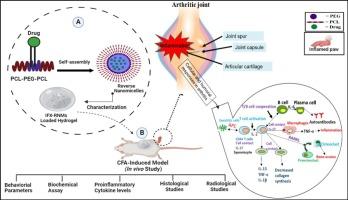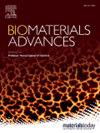大分子英夫利昔单抗负载反向纳米蜂窝透皮水凝胶:抗类风湿性关节炎的创新方法。
IF 5.5
2区 医学
Q2 MATERIALS SCIENCE, BIOMATERIALS
Materials Science & Engineering C-Materials for Biological Applications
Pub Date : 2024-10-30
DOI:10.1016/j.bioadv.2024.214093
引用次数: 0
摘要
英夫利昔单抗(IFX)是一种用于治疗类风湿性关节炎(RA)的生物治疗药物;然而,由于胃的酸碱度变化和酶降解,其生物活性口服后会丧失,生物利用度降低。作者试图通过透皮途径提高大分子的给药效果。先前合成的聚己内酯-聚乙二醇-聚己内酯(PCL-PEG-PCL)三嵌段共聚物被用作制备 IFX 负载反向纳米微孔(IFX-RNMs)的有效载体。通过纳米沉淀技术制备出的 RNMs 经过表征后被加入到以桉树油(EO)为渗透增强剂的 Carbopol 水凝胶中。优化后的 RNMs 的粒径为 72.32 nm,封装效率为 83%。体外释放显示出 IFX 从制备的载体系统中持续释放的模式,体外皮肤渗透和荧光显微镜研究显示,IFX-RNMs 与 EO 的水凝胶负载明显改善了渗透。对 CFA 诱导的 RA 小鼠模型进行的体内研究表明,该模型的行为参数、生化测定、组织病理学和放射学分析结果均有显著改善。总之,研究结果表明,IFX-RNMs 负载水凝胶可作为治疗 RA 的一种合适方法。本文章由计算机程序翻译,如有差异,请以英文原文为准。

A macromolecule infliximab loaded reverse nanomicelles-based transdermal hydrogel: An innovative approach against rheumatoid arthritis
Infliximab (IFX) is used as a biotherapeutic agent for the treatment of rheumatoid arthritis (RA); however, its biological activity is lost orally because of variations in gastric pH and enzymatic degradation, and reduced bioavailability. The authors have tried to improve the efficacy of macromolecule delivery through transdermal route. Polycaprolactone-Polyethylene glycol-Polycaprolactone (PCL-PEG-PCL) triblock copolymer previously synthesized and was used as an efficient carrier for the preparation of IFX loaded reverse nanomicelles (IFX-RNMs). The RNMs were fabricated via nanoprecipitation technique, characterized and then were incorporated into a Carbopol-based hydrogel with eucalyptus oil (EO) as a penetration enhancer. The optimized RNMs had a particle size of 72.32 nm and an encapsulation efficiency of 83 %. In vitro release, exhibited a sustained pattern of IFX from the prepared carrier system, ex-vivo skin permeation and fluorescence microscopic studies revealed that IFX-RNMs loaded hydrogel with EO markedly improved permeation. An in vivo study was carried out on a CFA-induced RA mice model that revealed significant improvements in the results of behavioral parameters, biochemical assays, histopathological and radiological analysis. Overall, the results concluded that the IFX-RNMs loaded hydrogel can be used as a suitable approach for treating RA.
求助全文
通过发布文献求助,成功后即可免费获取论文全文。
去求助
来源期刊
CiteScore
17.80
自引率
0.00%
发文量
501
审稿时长
27 days
期刊介绍:
Biomaterials Advances, previously known as Materials Science and Engineering: C-Materials for Biological Applications (P-ISSN: 0928-4931, E-ISSN: 1873-0191). Includes topics at the interface of the biomedical sciences and materials engineering. These topics include:
• Bioinspired and biomimetic materials for medical applications
• Materials of biological origin for medical applications
• Materials for "active" medical applications
• Self-assembling and self-healing materials for medical applications
• "Smart" (i.e., stimulus-response) materials for medical applications
• Ceramic, metallic, polymeric, and composite materials for medical applications
• Materials for in vivo sensing
• Materials for in vivo imaging
• Materials for delivery of pharmacologic agents and vaccines
• Novel approaches for characterizing and modeling materials for medical applications
Manuscripts on biological topics without a materials science component, or manuscripts on materials science without biological applications, will not be considered for publication in Materials Science and Engineering C. New submissions are first assessed for language, scope and originality (plagiarism check) and can be desk rejected before review if they need English language improvements, are out of scope or present excessive duplication with published sources.
Biomaterials Advances sits within Elsevier''s biomaterials science portfolio alongside Biomaterials, Materials Today Bio and Biomaterials and Biosystems. As part of the broader Materials Today family, Biomaterials Advances offers authors rigorous peer review, rapid decisions, and high visibility. We look forward to receiving your submissions!

 求助内容:
求助内容: 应助结果提醒方式:
应助结果提醒方式:


